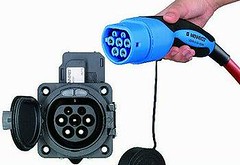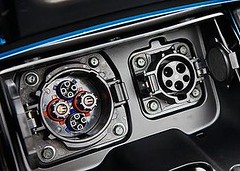 歐盟執委會宣布統一歐盟中電動車的充電插座,由德國Mennekes公司所製造的「第二型」(Type 2)插座作為標準的規格。
歐盟執委會宣布統一歐盟中電動車的充電插座,由德國Mennekes公司所製造的「第二型」(Type 2)插座作為標準的規格。
在歐洲車商引頸期盼下,歐盟執委會23日宣布,此標準規格插座將成為全歐替代燃料補充站的標準設備,所有的燃料加注站業者都必須使用相同的設計。
歐盟執委會指出,使用清潔燃料可以減少溫室氣體的排放,但阻礙清潔燃料推廣的障礙有三,分別是:油電汽車所費不貲、消費者購買意願低、缺少充電站及補充燃料站。
現在的情況是,因為沒有足夠的電動車,所以燃料加注站的數量很少;因為需求量少,所以電動車的價格居高不下;而電動車高貴的價格和缺乏燃料補充站則又導致消費者拒絕購買電動車。
為了打破這個循環,歐盟執委會提出使用清潔能源與共通規格設備的「清潔動力運輸方案」(Clean Power for Transport Package),並訂定各會員國共同建立電力、氫氣、天然氣等清潔燃料基礎設施普及化的最低要求。
負責交通相關事宜的歐盟執委會副主席Siim Kallas表示,「中國和美國做出共識,他們預計在2020年國內將會有6百萬台電動車,這是我們歐洲在這快速成長的全球市場中占有一席之地的好機會。」
歐洲汽車製造業公會的秘書長Ivan Hodac說,「從長程目標來看,油電汽車是我們所面臨機動性問題的解決方法。然而,成功實行的先決條件是要建立一個正確且合適的環境。
我們希望可以省下消費者開電動車到不同國家或地區時,還得自己帶著充電線的麻煩,像現在的手機就是這樣的情況。」
到2012年11月為止,歐洲約有1萬5千座的電動車燃料加注充電站 ,但各國不同規格的插座卻使得問題陷入複雜的狀況之中。例如,只有法國在使用的第三型(Type 3)充電座,可以相容於所有符合歐盟國家級標準的建築物和插座。
 而德國使用的是由Mennekes公司製造的第二型充電座,這一型的插座交流電與直流電兩者皆適用,現在歐盟宣布它們作為全歐統一的標準規格。
而德國使用的是由Mennekes公司製造的第二型充電座,這一型的插座交流電與直流電兩者皆適用,現在歐盟宣布它們作為全歐統一的標準規格。
這款德製充電器沒有防止觸電的檔板,目前在英國、西班牙、義大利、瑞士、芬蘭等國家將檔板訂為必要零件,因此在這些國家中尚無法通行。
在美國,汽車工程協會選擇同樣可以接受直流電與交流電的J1772插座作為標準規格。
其競爭對手是由日本日產及三菱汽車等支持的CHAdeMO插座。兩者在外型與內部充電的電路上皆相異,所以駕駛只靠一個轉接插頭就想對應所有的系統是不行的。
日本產的車子,如三菱的i-MiEV和日產的Leaf,都已經安裝了CHAdeMO插座,這種插座是為了可以快速充電的高電壓、高電流直流電所設計。
情況相當複雜,想了解更多油電汽車充電標準的詳細內容請到這個網站。
歐盟執委會已規劃全套電動車普及藍圖
歐盟執委會的規劃案也提及,基礎數量的燃料加注站建設好後,進一步規定27個會員國要全部使用相同的插座規格。最終目標是建立大量的燃料加注站,促使汽車公司製造大量的油電汽車進而使價錢回到合理的範圍。
這個方案包含一個串連全歐替代燃料的策略、關於基礎建設的指示、以及一份描述液化天然氣運輸狀況的文件。
這個方案中涵蓋了所有汽車的主要燃料:
氫氣:德國、義大利、丹麥國內已設有氫氣加汽站,其中的幾座尚未開放給大眾。但為了建立共同標準尚須增加添加燃料所需之軟管等零件。
在這樣的前提之下,現有的氫氣加汽站將可以與新的標準規格組成一完整網路,確保氫氣車的運行。目前有14個會員國已建立起氫氣網路。
生質燃料:此種燃料已有大約5%的市占率。它們的作用主要在於混合其他燃料,它們不需要特定的設施便可使用。唯一可能會面對的挑戰是如何確保其穩定發展的持續性。
液化天然氣:液化天然氣過去主要作為卡車的燃料,然而全歐境內目前只有38座液化天然氣加氣站。歐盟執委會承諾到2020年時,在全歐核心交通網絡上每400公里就會設一座燃料加注站。
壓縮天然氣:這種燃料主要是應用在一般汽車上,現在約有100萬輛車用壓縮天然氣做為燃料,大約占歐盟中0.5%左右的比率,天然氣工業目標在2020年使數量增加到現今這個數據的10倍。
委員會的提案將會確保壓縮天然氣加注站的使用,加上共同標準規格的插座,在2020年全歐境內最少每150公里就能有一座燃料加注站。
關於液化石油氣方面,因為其設施早已建好所以不會有任何相關的建設規劃。
Kallas副主席建議,會員國可以提出政策鼓勵民間企業投資以減少公共資金的開銷。歐盟現在已經得到全歐交通網絡基金會持續且有計畫性的支持。
Hodac說,「只有在公用事業供應商、基礎設施公司、能源業者、標準化機構和汽車工業的全力配合下,這項計畫才能確實順利進行。各國政府與歐洲機構的全力支持更是這個計畫不可或缺的推動力量。
The "Type 2″ plug developed by the German company Mennekes will be the common standard for charging electrified vehicles across the European Union, the European Commission has announced.
Long sought by EU automakers, the common standard was announced Thursday as part of a set measures to build alternative fuel stations across Europe with common standards for their design and use.
Clean fuel that helps reduce greenhouse gas emissions is being held back by three main barriers, the Commission said – the high cost of vehicles, a low level of consumer acceptance, and the lack of recharging and refueling stations.
In this small circle, refueling stations are not being built because there are not enough vehicles.
Vehicles are not sold at competitive prices because there is not enough demand.
Consumers don't buy the vehicles because they are expensive and the refueling stations are not there.
To break the circle, the Commission is proposing the Clean Power for Transport Package, with the common EU wide standard for plug-in charging equipment as well as binding targets on Member States for a minimum level of infrastructure for clean fuels such as electricity, hydrogen and natural gas.
European Commission Vice President Siim Kallas, who is responsible for transport, said, "Between them, China and the U.S. plan to have more than six million electric vehicles on the road by 2020," said Kallas. "This is major opportunity for Europe to establish a strong position in a fast-growing global market."
"E-mobility can be part of a long-term solution to our mobility challenges. However, we need to have the right framework conditions if it is to really take off," Ivan Hodac, Secretary General of the European Automobile Manufacturers' Association said.
"We want to avoid a situation where customers have to carry a multitude of charging cables to use their vehicles in different cities, regions and countries, just as we see today with items like mobile phones," he said.
As of November 2012, about 15,000 electric vehicle charging stations had been installed in Europe. But EV charging has become complicated with different standards in use in various countries.
Only France has a Type-3 charger format, compatible with all national European codes for use in buildings and connection to the electric grid.
Germany uses the Mennekes Type-2 charging plug. It is this plug that has now been proposed as the common standard for the whole of Europe. The charging coupler is suited for both AC and DC charging.
The German connector has no shutter, a cover to prevent electrocution when the plug is not in use. Currently, this makes it impossible to use in England, Spain, Italy, Sweden and Finland, where a shutter cover is required.
In the United States, the Society of Automotive Engineers has selected the J1772 combo plug as the standard, which also allows for both AC and DC charging using the same plug.
The rival CHAdeMO standard is supported by Japanese automakers such as Nissan and Mitsubishi. The physical connectors are different shapes, and the protocols that control the chargers are different too, so a drivers cannot use a single plug adapter for all systems.
CHAdeMo is already installed on Japanese cars like the Mitsubishi i-MiEV and the Nissan Leaf. CHAdeMO is a form of DC Fast Charge, for high-voltage, high-current automotive fast charging.
It's complicated. For more complete information on electric vehicle charging standards, click here.
Under the Clean Power for Transport Package a minimum number of recharging points, using a common plug, will be required for each of the 27 EU Member States. The aim is to put in place a critical mass of charging points so that companies will mass produce the cars at reasonable prices.
The entire package includes a Communication on a European alternative fuels strategy, a Directive focusing on infrastructure and standards and a document describing a plan for the development of liquefied natural gas (LNG) in shipping.
The package covers all the main automotive fuels:
Hydrogen: Germany, Italy and Denmark already have some hydrogen refuelling stations although some of them are not publically accessible. Common standards are still needed for certain components such as fuel hoses.
Under this proposal, existing filling stations will be linked up to form a network with common standards ensuring the mobility of hydrogen vehicles. This applies to the 14 Member States which currently have a Hydrogen network.
Biofuels: already have nearly five percent of the market. They work as blended fuels and do not require any specific infrastructure. A key challenge will be to ensure their sustainability.
LNG: Liquefied natural gas is used to fuel trucks, but there are only 38 filling stations in the entire European Union. The Commission is proposing that by 2020, refuelling stations are installed every 400 kilometers (250 miles) along the roads of the Trans European Core Network.
CNG: Compressed natural gas is mainly used for cars. One million vehicles currently use this fuel representing 0.5 percent of the EU fleet – the industry aims to increase this figure 10-fold by 2020.
The Commission's proposal will ensure that publicly accessible CNG refueling points, with common standards, are available Europe-wide with maximum distances of 150 Km by 2020.
No action is foreseen for liquefied petroleum gas, LPG, because the core infrastructure is already established.
Member States will be able to implement these changes without public spending by changing local regulations to encourage private sector investment and behavior, Commissioner Kallas said. EU financial support is already available from TEN-T funds, cohesion and structural funds.
"It will only be possible to book real progress if there is full cooperation between utility providers, infrastructure companies, the energy sector, standardization bodies and the automotive industry," said Hodac. "The full support of national governments and the European institutions" is critical to this effort.
※ 全文及圖片詳見:ENS





